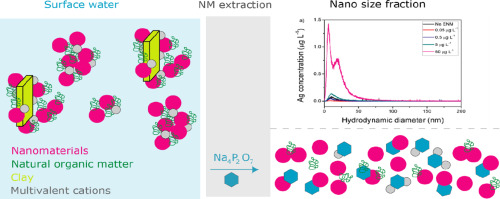当前位置:
X-MOL 学术
›
Sci. Total Environ.
›
论文详情
Our official English website, www.x-mol.net, welcomes your
feedback! (Note: you will need to create a separate account there.)
Analysis of engineered nanomaterials (Ag, CeO2 and Fe2O3) in spiked surface waters at environmentally relevant particle concentrations.
Science of the Total Environment ( IF 8.2 ) Pub Date : 2020-01-25 , DOI: 10.1016/j.scitotenv.2020.136927 Frédéric Loosli 1 , Jingjing Wang 1 , Mithun Sikder 1 , Kamelia Afshinnia 1 , Mohammed Baalousha 1
Science of the Total Environment ( IF 8.2 ) Pub Date : 2020-01-25 , DOI: 10.1016/j.scitotenv.2020.136927 Frédéric Loosli 1 , Jingjing Wang 1 , Mithun Sikder 1 , Kamelia Afshinnia 1 , Mohammed Baalousha 1
Affiliation

|
Quantification of engineered nanomaterials (ENMs) concentrations in surface waters remains one of the key challenges in environmental nanoscience and nanotechnology. A promising approach to estimate metal and metal oxide ENM concentrations in complex environmental samples is based on the increase in the elemental ratios of ENM-contaminated samples relative to the corresponding natural background elemental ratios. This contribution evaluated the detection and quantification of Ag, CeO2, and Fe2O3 ENMs spiked in synthetic soft, or in natural river waters using the elemental ratio approach, and evaluated the effect of extractants including sodium hydroxide (NaOH), sodium oxalate (Na2C2O4) and sodium pyrophosphate (Na4P2O7) on the recovery of ENMs from the spiked waters. The extracted ENM concentrations were higher in Na4P2O7-extracted suspensions than in NaOH- and Na2C2O4-extracted suspensions due to the higher efficiency of Na4P2O7 to break up natural and engineered nanomaterial heteroaggregates. The size distributions of the extracted suspensions were determined by asymmetrical flow-field flow fractionation coupled to inductively coupled plasma-mass spectrometer (AF4-ICP-MS). These size distribution analysis demonstrated that Ag ENMs were extracted from the spiked river water as both primary particles and small (<100 nm) aggregates, whereas CeO2 ENMs were extracted from the spiked river water as aggregates of particles in the size range 0-200 nm. The number particle size distribution of the extracted suspensions confirmed that Ag ENMs were extracted as a mixture of primary and aggregated Ag ENMs. Small Ag ENMs (i.e. <20 nm) were detected by AF4-ICP-MS, but these particles were not detected by single particle (sp)-ICP-MS due to high size detection limit of sp-ICP-MS. This study illustrates that the elemental ratio approach is a promising approach to detect and quantify ENMs in surface waters. This study also illustrates the need for a multi-method approach, including extraction, filtration, AF4-ICP-MS and sp-ICP-MS, to detect, quantify, and characterize ENMs in surface waters.
中文翻译:

在与环境有关的颗粒浓度下,对加标地表水中的工程纳米材料(Ag,CeO2和Fe2O3)进行分析。
地表水中工程纳米材料(ENMs)浓度的量化仍然是环境纳米科学和纳米技术面临的主要挑战之一。估计复杂环境样品中金属和金属氧化物ENM浓度的一种有前途的方法是基于受ENM污染的样品的元素比相对于相应的自然背景元素比的增加。该贡献评估了使用元素比率法对合成软水或天然河水中加标的Ag,CeO2和Fe2O3 ENM的检测和定量,并评估了包括氢氧化钠(NaOH),草酸钠(Na2C2O4)和焦磷酸钠(Na4P2O7)对从加标水中回收的ENM的影响。在Na4P2O7提取的悬浮液中,提取的ENM浓度高于在NaOH和Na2C2O4提取的悬浮液中,因为Na4P2O7分解天然和工程纳米材料异质聚集体的效率更高。提取的悬浮液的尺寸分布通过与电感耦合等离子体质谱仪(AF4-ICP-MS)耦合的不对称流场流动分馏来确定。这些尺寸分布分析表明,从掺入的河水中提取的Ag ENMs既是初级颗粒又是小的(<100 nm)聚集体,而CeO2 ENMs则从掺入的河水中提取了0-200 nm范围内的颗粒聚集体。提取的悬浮液的数量粒度分布证实,Ag ENM被提取为主要和聚集的Ag ENM的混合物。AF4-ICP-MS检测到小的Ag ENM(即<20 nm),但是由于sp-ICP-MS的高检测限,单颗粒(sp)-ICP-MS无法检测到这些颗粒。这项研究表明,元素比率法是检测和定量地表水中ENM的有前途的方法。这项研究还表明,需要采用多种方法来检测,定量和表征地表水中的ENM,包括萃取,过滤,AF4-ICP-MS和sp-ICP-MS。
更新日期:2020-01-26
中文翻译:

在与环境有关的颗粒浓度下,对加标地表水中的工程纳米材料(Ag,CeO2和Fe2O3)进行分析。
地表水中工程纳米材料(ENMs)浓度的量化仍然是环境纳米科学和纳米技术面临的主要挑战之一。估计复杂环境样品中金属和金属氧化物ENM浓度的一种有前途的方法是基于受ENM污染的样品的元素比相对于相应的自然背景元素比的增加。该贡献评估了使用元素比率法对合成软水或天然河水中加标的Ag,CeO2和Fe2O3 ENM的检测和定量,并评估了包括氢氧化钠(NaOH),草酸钠(Na2C2O4)和焦磷酸钠(Na4P2O7)对从加标水中回收的ENM的影响。在Na4P2O7提取的悬浮液中,提取的ENM浓度高于在NaOH和Na2C2O4提取的悬浮液中,因为Na4P2O7分解天然和工程纳米材料异质聚集体的效率更高。提取的悬浮液的尺寸分布通过与电感耦合等离子体质谱仪(AF4-ICP-MS)耦合的不对称流场流动分馏来确定。这些尺寸分布分析表明,从掺入的河水中提取的Ag ENMs既是初级颗粒又是小的(<100 nm)聚集体,而CeO2 ENMs则从掺入的河水中提取了0-200 nm范围内的颗粒聚集体。提取的悬浮液的数量粒度分布证实,Ag ENM被提取为主要和聚集的Ag ENM的混合物。AF4-ICP-MS检测到小的Ag ENM(即<20 nm),但是由于sp-ICP-MS的高检测限,单颗粒(sp)-ICP-MS无法检测到这些颗粒。这项研究表明,元素比率法是检测和定量地表水中ENM的有前途的方法。这项研究还表明,需要采用多种方法来检测,定量和表征地表水中的ENM,包括萃取,过滤,AF4-ICP-MS和sp-ICP-MS。











































 京公网安备 11010802027423号
京公网安备 11010802027423号